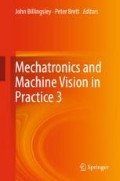Abstract
Sign language is used as the means of communication by the speech-impaired. It is a language which uses hand gestures and movements to convey meaning. Several studies have attempted to use computers to recognize hand gestures using either a data glove, which uses several sensors to determine hand pose and attitude, or a vision based system, which uses a camera to determine the hand position and gestures made. We introduce a system that combines a prototype data glove with computer vision in order to translate Filipino Sign Language for medical purposes. The system uses the Viterbi algorithm to find the best gesture fit from the HMM modeling. Three training sets were used to validate the systems’ accuracy of recognition. The first set focused on the alphabet and numbers and achieved a recognition accuracy of 71.8%. The second training set was composed of health-care related words, which produced a recognition rate of 80.6%. The third set comprised the full vocabulary of 26 letters of the alphabet, numbers zero to nine, and 30 words commonly used in health-care related work, resulting in an accuracy of 80.55%.
Access this chapter
Tax calculation will be finalised at checkout
Purchases are for personal use only
References
Abuan, M. (2009). Calls made for a national language for the deaf. The Carillon [Online]. Available http://archive.is/mrGi4.
Aguilos, V., C. Mariano, E. Mendoza, and J. Orense. 2007. A portable letter sign language translator. Manila: De La Salle University Library.
Aoki, N., K. Uda, T. Kiuchi, and T. Fukui. 2008. Impact of miscommunication in medical dispute cases in Japan. International Journal for Quality in Health Care 20 (5): 358–362.
Bose, A. 2013. How to detect and track red objects in live video in MATLAB Arindam’s Blog, November, 10 2013. [Online]. Available http://arindambose.com/blog/?p=72.
Krishna, R., S. Lee, S.P. Wang, and J. Lang. 2012. Sign language translation. [Online]. Available: http://people.ece.cornell.edu/land/courses/ece4760/FinalProjects/s2012/sl787_rak248_sw525_fl229/sl787_rak248_sw525_fl229/index.htm.
Martinez, L. 2004. An introduction to Filipino sign language. Manila: Philippine Deaf Resource Center.
Martinez, L. 2012. Primer on Filipino sign language. [Online]. Available http://opinion.inquirer.net/41909/primer-on-filipino-sign-language. (Accessed October 22, 2014).
Philippine Statistics Authority. 2000. Census of population and housing, special report on persons with disabilities. [Online] Available https://psa.gov.ph/sites/default/files/2000CPHSpecialReportonPersonWithDisability.pdf. ISSN 0117-1453.
Registry of Interpreters for the Deaf. 2007. Interpreting in health care settings. [Online]. Available https://drive.google.com/file/d/0B3DKvZMflFLdYVVBd0RIWDlOMW8/view.
Rodriguez-Fuentes, L.J., and M.I. Torres 2003. Comparative study of the Baum-Welch and Viterbi training algorithms applied to read and spontaneous speech recognition. In Pattern Recognition and Image Analysis, First Iberian Conference, IbPRIA.
Westeyn, T., H. Brashear, A. Atrash, and T. Starner. 2003. Georgia tech gesture toolkit: Supporting experiments in gesture recognition—International conference on perceptive and multimodal user interfaces.
Zimmerman, T., J. Lanier, C. Blanchard, S. Bryson, and Y. Harvil. 1987. A hand gesture interface device. In Conference on Human Factors in Computing Systems and Graphic Interface, Redwood City.
Acknowledgements
We would like to thank Maria Elena Lozada and John Xandre C. Baliza of De La Salle—College of Saint Benilde School of Deaf Education and Applied Studies for their tutelage of Filipino Sign Language.
Author information
Authors and Affiliations
Corresponding author
Editor information
Editors and Affiliations
Rights and permissions
Copyright information
© 2018 Springer International Publishing AG, part of Springer Nature
About this chapter
Cite this chapter
Ong, C., Lim, I., Lu, J., Ng, C., Ong, T. (2018). Sign-Language Recognition Through Gesture & Movement Analysis (SIGMA). In: Billingsley, J., Brett, P. (eds) Mechatronics and Machine Vision in Practice 3. Springer, Cham. https://doi.org/10.1007/978-3-319-76947-9_17
Download citation
DOI: https://doi.org/10.1007/978-3-319-76947-9_17
Published:
Publisher Name: Springer, Cham
Print ISBN: 978-3-319-76946-2
Online ISBN: 978-3-319-76947-9
eBook Packages: EngineeringEngineering (R0)

